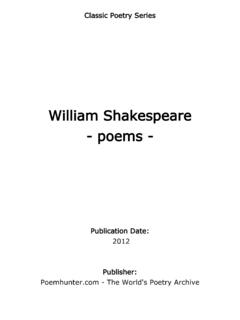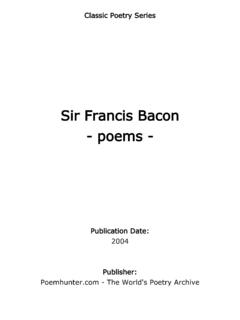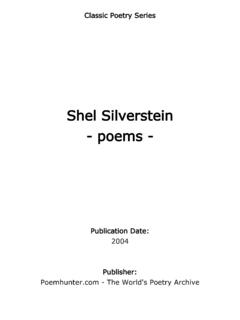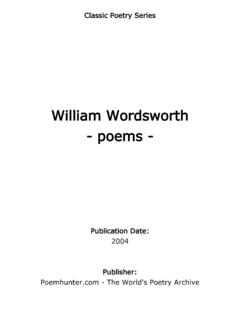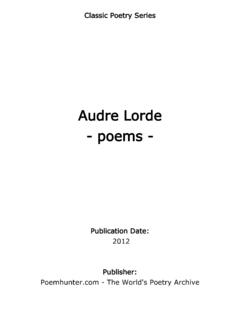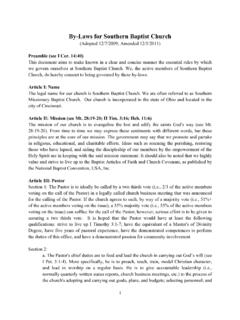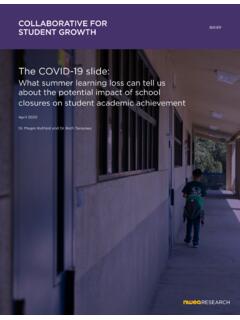Transcription of Emily Dickinson - poems - Poem Hunter
1 Classic Poetry Series Emily Dickinson - poems - Publication Date: 2012 - The World's Poetry ArchiveEmily Dickinson (10 December 1830 15 May 1886) Emily Elizabeth Dickinson was an American poet. Born in Amherst,Massachusetts, to a successful family with strong community ties, she lived amostly introverted and reclusive life. After she studied at the Amherst Academyfor seven years in her youth, she spent a short time at Mount Holyoke FemaleSeminary before returning to her family's house in Amherst. Thought of as aneccentric by the locals, she became known for her penchant for white clothingand her reluctance to greet guests or, later in life, even leave her room.
2 Most ofher friendships were therefore carried out by correspondence. Although Dickinson was a prolific private poet, fewer than a dozen of her nearlyeighteen hundred poems were published during her lifetime. The work that waspublished during her lifetime was usually altered significantly by the publishers tofit the conventional poetic rules of the time. Dickinson 's poems are unique for theera in which she wrote; they contain short lines, typically lack titles, and oftenuse slant rhyme as well as unconventional capitalization and punctuation. Manyof her poems deal with themes of death and immortality, two recurring topics inletters to her friends.
3 Although most of her acquaintances were probably aware of Dickinson 's writing,it was not until after her death in 1886 when Lavinia, Emily 's younger sister,discovered her cache of poems that the breadth of Dickinson 's work becameapparent. Her first collection of poetry was published in 1890 by personalacquaintances Thomas Wentworth Higginson and Mabel Loomis Todd, both ofwhom heavily edited the content. A complete and mostly unaltered collection ofher poetry became available for the first time in 1955 when The poems of EmilyDickinson was published by scholar Thomas H.
4 Johnson. Despite unfavorablereviews and skepticism of her literary prowess during the late 19th and early20th century, critics now consider Dickinson to be a major American poet <b>Family and Childhood</b> Emily Elizabeth Dickinson was born at the family's homestead in Amherst,Massachusetts, on December 10, 1830, into a prominent, but not wealthy,family. Two hundred years earlier, the Dickinsons had arrived in the NewWorld in the Puritan Great Migration where they prospered. Emily Dickinson 'spaternal grandfather, Samuel Dickinson , had almost single-handedly foundedAmherst College.
5 In 1813 he built the homestead, a large mansion on the town'sMain Street, that became the focus of Dickinson family life for the better part of acentury. Samuel Dickinson 's eldest son, Edward, was treasurer of - The World's Poetry ArchiveCollege for nearly forty years, served numerous terms as a State Legislator, andrepresented the Hampshire district in the United States Congress. On May 6,1828, he married Emily Norcross from Monson. They had three children: William Austin (1829 1895), known as Austin, Aust or Awe; Emily Elizabeth; and Lavinia Norcross (1833 1899), known as Lavinia or Vinnie.
6 By all accounts, young Emily was a well-behaved girl. On an extended visit toMonson when she was two, Emily 's Aunt Lavinia described Emily as "perfectlywell & contented She is a very good child & but little trouble." Emily 's aunt alsonoted the girl's affinity for music and her particular talent for the piano, whichshe called "the moosic". Dickinson attended primary school in a two-story building on Pleasant Street. Hereducation was "ambitiously classical for a Victorian girl". Her father wanted hischildren well-educated and he followed their progress even while away onbusiness.
7 When Emily was seven, he wrote home, reminding his children to"keep school, and learn, so as to tell me, when I come home, how many newthings you have learned". While Emily consistently described her father in awarm manner, her correspondence suggests that her mother was regularly coldand aloof. In a letter to a confidante, Emily wrote she "always ran Home to Awe[Austin] when a child, if anything befell me. He was an awful Mother, but I likedhim better than none." On September 7, 1840, Dickinson and her sister Lavinia started together atAmherst Academy, a former boys' school that had opened to female studentsjust two years earlier.
8 At about the same time, her father purchased a house onNorth Pleasant Street. Emily 's brother Austin later described this large new homeas the "mansion" over which he and Emily presided as "lord and lady" while theirparents were absent. The house overlooked Amherst's burial ground, describedby one local minister as treeless and "forbidding". <b>Teenage Years</b> Dickinson spent seven years at the Academy, taking classes in English andclassical literature, Latin, botany, geology, history, "mental philosophy," andarithmetic. Daniel Taggart Fiske, the school's principal at the time, would laterrecall that Dickinson was "very bright" and "an excellent scholar, of exemplarydeportment, faithful in all school duties".
9 Although she had a few terms off due toillness the longest of which was in 1845 1846, when she was only enrolled foreleven weeks she enjoyed her strenuous studies, writing to a friend that - The World's Poetry ArchiveAcademy was "a very fine school". Dickinson was troubled from a young age by the "deepening menace" of death,especially the deaths of those who were close to her. When Sophia Holland, hersecond cousin and a close friend, grew ill from typhus and died in April, 1844, Emily was traumatized. Recalling the incident two years later, Emily wrote that"it seemed to me I should die too if I could not be permitted to watch over her oreven look at her face.
10 " She became so melancholic that her parents sent her tostay with family in Boston to recover. With her health and spirits restored, she soon returned to Amherst Academy tocontinue her studies. During this period, she first met people who were tobecome lifelong friends and correspondents, such as Abiah Root, Abby Wood,Jane Humphrey, and Susan Huntington Gilbert (who later married Emily 's brotherAustin). In 1845, a religious revival took place in Amherst, resulting in 46 confessions offaith among Dickinson 's peers. Dickinson wrote to a friend the following year: "Inever enjoyed such perfect peace and happiness as the short time in which I feltI had found my savior.
